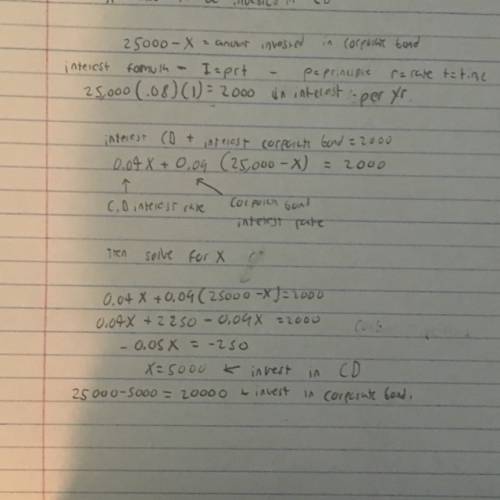
Mathematics, 12.10.2019 19:30 KeyesRaveen
Steve has $25,000 to invest and wishes to earn an overall annual rate of return of 8%. his financial advisor recommends that he invest some of the money in a 5-year cd paying 4% per annum and the rest in a corporate bond paying 9% per annum. how much should steve place in each investment in order to achieve his goal?
if you can solve this, can you show your work and explain what i need to plug in where, and what equation i need to use? this is so confusing.

Answers: 2
Another question on Mathematics


Mathematics, 21.06.2019 21:30
In δabc shown below, ∠bac is congruent to ∠bca: triangle abc, where angles a and c are congruent given: base ∠bac and ∠acb are congruent. prove: δabc is an isosceles triangle. when completed (fill in the blanks), the following paragraph proves that line segment ab is congruent to line segment bc making δabc an isosceles triangle. (4 points) construct a perpendicular bisector from point b to line segment ac . label the point of intersection between this perpendicular bisector and line segment ac as point d: m∠bda and m∠bdc is 90° by the definition of a perpendicular bisector. ∠bda is congruent to ∠bdc by the definition of congruent angles. line segment ad is congruent to line segment dc by by the definition of a perpendicular bisector. δbad is congruent to δbcd by the line segment ab is congruent to line segment bc because consequently, δabc is isosceles by definition of an isosceles triangle. 1. corresponding parts of congruent triangles are congruent (cpctc) 2. the definition of a perpendicular bisector 1. the definition of a perpendicular bisector 2. the definition of congruent angles 1. the definition of congruent angles 2. the definition of a perpendicular bisector 1. angle-side-angle (asa) postulate 2. corresponding parts of congruent triangles are congruent (cpctc)
Answers: 1

Mathematics, 21.06.2019 23:00
Describe the end behavior of the function below. f(x)=(2/3)^x-2 a. as x increases, f(x) approaches infinity. b. as x decreases, f(x) approaches 2. c. as x increases, f(x) approaches -2. d. as x decreases, f(x) approaches negative infinity.
Answers: 1

Mathematics, 22.06.2019 01:30
What is the remainder when 3x^2-x-10 is divided by x-1 -6,-7,-8, or -9
Answers: 1
You know the right answer?
Steve has $25,000 to invest and wishes to earn an overall annual rate of return of 8%. his financial...
Questions

Mathematics, 19.02.2021 04:00

History, 19.02.2021 04:00

Mathematics, 19.02.2021 04:00




Mathematics, 19.02.2021 04:00

Mathematics, 19.02.2021 04:00





Computers and Technology, 19.02.2021 04:00



Mathematics, 19.02.2021 04:00

Mathematics, 19.02.2021 04:00


Chemistry, 19.02.2021 04:00




